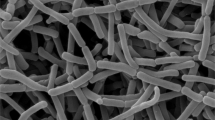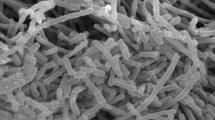Abstract
Two novel actinomycetes, designated strains CFH S0322T and CFH S01580T, were isolated from soil samples collected from Xuchang city and Ji Guan cave in Henan province, China, respectively. Their taxonomic positions were investigated by a polyphasic approach. The two isolates were Gram-reaction positive, non-motile, aerobic and catalase-positive actinomycetes. Phylogenetic analysis based on 16S rRNA gene sequence comparisons showed that the two isolates are closely related to the members of the genus Amycolatopsis, sharing high similarities with Amycolatopsis magusensis KCTC 29056T (99.1 %, CFH S0322T) and Amycolatopsis nigrescens DSM 44992T (98.1 %, CFH S01580T), respectively. The major whole cell sugars of strains CFH S0322T and CFH S01580T were arabinose and galactose and the predominant menaquinone was MK-9(H4). The genomic DNA G+C contents of strains CFH S0322T and CFH S01580T were 70.6 and 68.6 mol%, respectively. Morphological, phylogenetic and chemotaxonomic results suggest that strains CFH S0322T and CFH S01580T are representatives of two new species, for which the names Amycolatopsis xuchangensis sp. nov. and Amycolatopsis jiguanensis sp. nov. are proposed. The type strains are CFH S0322T (=NBRC 110769T =KCTC 39516T) and CFH S01580T (=DSM 101526T =CCTCC AA 2015032T).

Similar content being viewed by others
References
Bian J, Li Y, Wang J, Song FH, Liu M, Dai HQ, Ren B, Gao H, Hu X, Liu ZH, Li WJ, Zhang LX (2009) Amycolatopsis marina sp. nov., an actinomycete isolated from an ocean sediment. Int J Syst Evol Microbiol 59:477–481
Christensen H, Angen O, Mutters R, Olsen JE, Bisgaard M (2000) DNA–DNA hybridization determined in micro-wells using covalent attachment of DNA. Int J Syst Evol Microbiol 50:1095–1102
Collins M, Jones D (1980) Lipids in the classification and identification of coryneform bacteria containing peptidoglycans based on 2, 4-diaminobutyric acid. J Appl Bacteriol 48:459–470
Collins M, Pirouz T, Goodfellow M, Minnikin D (1977) Distribution of menaquinones in actinomycetes and corynebacteria. J Gen Microbiol 100:221–230
Duangmal K, Mingma R, Pathom-Aree W, Thamchaipenet A, Inahashi Y, Matsumoto A, Takahashi Y (2011) Amycolatopsis samaneae sp. nov., isolated from roots of Samanea saman (Jacq.) Merr. Int J Syst Evol Microbiol 61:951–955
Embley TM, Smida J, Stackebrandt E (1988) The phylogeny of mycolate-less wall chemotype IV actinomycetes and descirption of Pseudonocardiaceae fam. nov. Syst Appl Microbiol 11:44–52
Ezaki T, Hashimoto Y, Yabuuchi E (1989) Fluorometric deoxyribonucleic acid-deoxyribonucleic acid hybridization in microdilution wells as an alternative to membrane filter hybridization in which radioisotopes are used to determine genetic relatedness among bacterial strains. Int J Syst Evol Microbiol 39:224–229
Felsenstein J (1981) Evolutionary trees from DNA sequences: a maximum likelihood approach. J Mol Evol 17:368–376
Felsenstein J (1985) Confidence limits on phylogenies: an approach using the bootstrap. Evolution 39:783–791
Fitch WM (1971) Toward defining the course of evolution: minimum change for a specific tree topology. Systematic zoology 20:406–416
Gonzalez C, Gutierrez C, Ramirez C (1978) Halobacterium vallismortis sp. nov. An amylolytic and carbohydrate-metabolizing, extremely halophilic bacterium. Can J Microbiol 24:710–715
Gram HC (1884) Über die isolierte Färbung der Schizomyceten in Schnitt-und Trockenpräparaten. Fortschr Med 2:185–189
Groth I, Tan GYA, González JM, Laiz L, Carlsohn MR, Schütze B, Wink J, Goodfellow M (2007) Amycolatopsis nigrescens sp. nov., a thermophilic actinomycete isolated from soil. Int J Syst Evol Microbiol 57:513–519
Hu HY, Lim BR, Goto N, Fujie K (2001) Analytical precision and repeatability of respiratory quinones for quantitative study of microbial community structure in environmental samples. J Microbiol Methods 47:17–24
Kelly KL (1964) Color-name charts illustrated with centroid colors. Inter-Society Color Council-National Bureau of Standards, Chicago
Kim B, Sahin N, Tan GYA, Zakrzewska-Czerwinska J, Goodfellow M (2002) Amycolatopsis eurytherma sp. nov., a thermophilic actinomycete isolated from soil. Int J Syst Evol Microbiol 52:889–894
Kim OS, Cho YJ, Lee K, Yoon SH, Kim M, Na H, Park SC, Jeon YS, Lee J-H, Yi H (2012) Introducing EzTaxon-e: a prokaryotic 16S rRNA gene sequence database with phylotypes that represent uncultured species. Int J Syst Evol Microbiol 62:716–721
Kimura M (1980) A simple method for estimating evolutionary rates of base substitutions through comparative studies of nucleotide sequences. J Mol Evol 16:111–120
Kimura M (1984) The neutral theory of molecular evolution. Cambridge University Press, New York
Kovacs N (1956) Identification of Pseudomonas pyocyanea by the oxidase reaction. Williams & Wilkins Co, Baltimore
Labeda DP, Donahue JM, Williams NM, Sells SF, Henton MM (2003) Amycolatopsis kentuckyensis sp. nov., Amycolatopsis lexingtonensis sp. nov. and Amycolatopsis pretoriensis sp. nov., isolated from equine placentas. Int J Syst Evol Microbiol 53:1601–1605
Lechevalier MP, De Lechevalier HA (1970) Chemical composition as a criterion in the classification of aerobic actinomycetes. Int J Syst Bacteriol 20:435–443
Lechevalier MP, De Bièvre C, Lechevalier HA (1977) Chemotaxonomy of aerobic actinomycetes: phospholipid composition. Biochem Syst Ecol 5:249–260
Lechevalier MP, Prauser H, Labeda DP, Ruan JS (1986) Two new genera of nocardioform actinomycetes: Amycolata gen. nov. and Amycolatopsis gen. nov. Int J Syst Bacteriol 36:29–37
Lee SD (2006) Amycolatopsis jejuensis sp. nov. and Amycolatopsis halotolerans sp. nov., novel actinomycetes isolated from a natural cave. Int J Syst Evol Microbiol 56:549–553
Lee SD (2009) Amycolatopsis ultiminotia sp. nov., isolated from rhizosphere soil, and emended description of the genus Amycolatopsis. Int J Syst Evol Microbiol 59:1401–1404
Leifson E (1960) Atlas of bacterial flagellation. Academic Press, London
Li WJ, Xu P, Schumann P, Zhang YQ, Pukall R, Xu LH, Stackebrandt E, Jiang CL (2007) Georgenia ruanii sp. nov., a novel actinobacterium isolated from forest soil in Yunnan (China), and emended description of the genus Georgenia. Int J Syst Evol Microbiol 57:1424–1428
MacFaddin JF (1976) Biochemical tests for identification of medical bacteria. Williams & Wilkins Co, Baltimore
Mesbah M, Premachandran U, Whitman WB (1989) Precise measurement of the G+C content of deoxyribonucleic acid by high-performance liquid chromatography. Int J Syst Evol Microbiol 39:159–167
Minnikin DE, Collins MD, Goodfellow M (1979) Fatty acid and polar lipid composition in the classification of Cellulomonas, Oerskovia and related taxa. J Appl Bacteriol 47:87–95
Minnikin DE, Hutchinson IG, Caldicott AB, Goodfellow M (1980) Thin layer chromatography of methanolysates of mycolic acid-containing bacteria. J Chromatogr 188:221–233
Minnikin DE, O’donnell AG, Goodfellow M, Alderson G, Athalye M, Schaal A, Parlett JH (1984) An integrated procedure for the extraction of bacterial isoprenoid quinones and polar lipids. J Microbiol Methods 2:233–241
Nie GX, Ming H, Li S, Zhou EM, Cheng J, Tang X, Feng HG, Tang SK, Li WJ (2012) Amycolatopsis dongchuanensis sp. nov., an actinobacterium isolated from soil. Int J Syst Evol Microbiol 62:2650–2656
Saitou N, Nei M (1987) The neighbor-joining method: a new method for reconstructing phylogenetic trees. Mol Biol Evol 4:406–425
Sasser M (1990) Identification of bacteria by gas chromatography of cellular fatty acids. USFCC Newsl 20:16
Shirling EB, Gottlieb D (1966) Methods for characterization of Streptomyces species. Int J Syst Bacteriol 16:313–340
Smibert R (1994) Phenotypic characterization. In: Gerhardt P, Murray RGE, Wood WA, Krieg NR (eds) Methods for general and molecular bacteriology. American Society for Microbiology, Washington, DC
Souza WR, Silva RE, Goodfellow M, Busarakam K, Figueiro FS, Ferreira D, Rodrigues-Filho E, Moraes LA, Zucchi TD (2015) Amycolatopsis rhabdoformis sp. nov., an actinomycete isolated from a tropical forest soil. Int J Syst Evol Microbiol 65:1786–1793
Staneck JL, Roberts GD (1974) Simplified approach to identification of aerobic actinomycetes by thin-layer chromatography. Appl Microbiol 28:226–231
Tamaoka J, Katayama-Fujimura Y, Kuraishi H (1983) Analysis of bacterial menaquinone mixtures by high performance liquid chromatography. J Appl Bacteriol 54:31–36
Tamura K, Stecher G, Peterson D, Filipski A, Kumar S (2013) MEGA6: molecular evolutionary genetics analysis version 6.0. Mol Biol Evol 30:2725–2729
Tang SK, Wang Y, Chen Y, Lou K, Cao LL, Xu LH, Li WJ (2009) Zhihengliuella alba sp. nov., and emended description of the genus Zhihengliuella. Int J Syst Evol Microbiol 59:2025–2032
Tang SK, Wang Y, Guan TW, Lee JC, Kim CJ, Li WJ (2010) Amycolatopsis halophila sp. nov., a halophilic actinomycete isolated from a salt lake. Int J Syst Evol Microbiol 60:1073–1078
Thompson JD, Gibson TJ, Plewniak F, Jeanmougin F, Higgins DG (1997) The CLUSTAL_X windows interface: flexible strategies for multiple sequence alignment aided by quality analysis tools. Nucleic Acids Res 25:4876–4882
Waksman SA (1967) The Actinomycetes. A Summary of Current Knowledege. Ronald Press, New York
Warwick S, Bowen T, Mcveigh H, Embley TM (1994) A phylogenetic analysis of the family Pseudonocardiaceae and the genera Actinokineospora and Saccharothrix with 16S rRNA sequences and a proposal to combine the genera Amycolata and Pseudonocardia in an emended genus Pseudonocardia. Int J Syst Bacteriol 44:293–299
Wayne LG, Brenner DJ, Colwell RR, Grimont PAD, Kandler O, Krichevsky MI, Moore LH et al (1987) International 21 committee on systematic bacteriology. Report of the ad hoc committee on reconciliation 22 of approaches to bacterial systematics. Int J Syst Bacteriol 37:463–464
Williams ST, Goodfellow M, Alderson G (1989) Genus Streptomyces Waksman and Henrici 1943, 339AL. In: William ST, Sharpe ME, Holt JG (eds) Bergey’s manual of systematic bacteriology, vol 4. Williams & Wilkins, Baltimore, pp 2452–2492
Zucchi TD, Tan GYA, Goodfellow M (2012) Amycolatopsis thermophila sp. nov. and Amycolatopsis viridis sp. nov., novel thermophilic actinomycetes isolated from Australian soil. Int J Syst Evol Microbiol 62:168–172
Acknowledgments
The authors are grateful to Miss Sang-Mi Lee (KCTC, Korea) and Dr. Rüdiger Pukall (DSMZ, Germany) for providing the reference type strains. This research was supported by Natural Science Foundation of China (No. 3150004), Program for Innovative Research Team (in Science and Technology) in University of Henan Province (14IRTSTHN013), Plan for Scientific Innovation Talent of Henan Province (154100510009), Science and technology research projects of Henan province (162102410056), Scientific Research Fund of Xinxiang Medical University (2013QN126). W.-J. L was also supported by the Guangdong Province Higher Vocational Colleges & Schools Pearl River Scholar Funded Scheme (2014).
Author information
Authors and Affiliations
Corresponding authors
Additional information
Jian-Rong Huang and Hong Ming have contributed equally to this work.
Electronic supplementary material
Below is the link to the electronic supplementary material.
Rights and permissions
About this article
Cite this article
Huang, JR., Ming, H., Li, S. et al. Amycolatopsis xuchangensis sp. nov. and Amycolatopsis jiguanensis sp. nov., isolated from soil. Antonie van Leeuwenhoek 109, 1423–1431 (2016). https://doi.org/10.1007/s10482-016-0742-1
Received:
Accepted:
Published:
Issue Date:
DOI: https://doi.org/10.1007/s10482-016-0742-1




